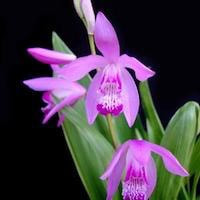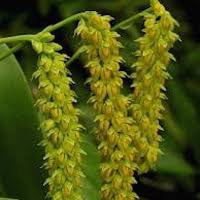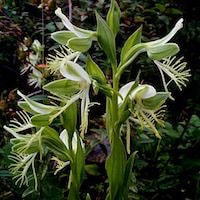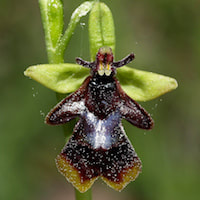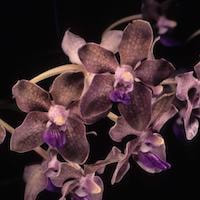WFR3- Women's Fresh 3 - In full bloom
|
Native Singaporean Orchid notes: Flickingeria Fimbriata
Flickingeria fimbriata, known for its watermelon-like fragrance, thrives on rocks near streams in lowland evergreen and semi-deciduous forests. It features vibrant yellow pseudobulbs and blooms with sweet-smelling flowers in spring, summer, and fall. Despite being challenging to cultivate, it holds cultural significance. In Sanskrit, it's called "Jivanti," meaning "life," revered for its tonic properties. This orchid has over three dozen names in India and is esteemed for its medicinal and mythical associations, including its potential as an aphrodisiac and as a candidate for the mythical Sanjeevani herb in the Ramayana.
|
Therapeutic Orchid notes:
|
Bletia hyacinthina
Bletia hyacinthina, known for its medicinal benefits, is traditionally used in the Malaya region for treating dysentery, hemorrhoids, and ague. It's particularly valued for its demulcent properties, soothing dyspepsia in children when applied on their abdomen. This orchid is also applied topically to heal burns, wounds, and various skin ailments, showcasing its therapeutic versatility in traditional medicine for gastrointestinal issues and skin conditions, highlighting its cultural significance and healing potential. |
|
Bulbophyllum cariniflorum and Bulbophyllum densiflorum
Bulbophyllum cariniflorum and Bulbophyllum densiflorum, known as Jianyeshiduo Lan in Chinese and Sumura in India, thrive in moist habitats across China, northern Thailand, northeast India, Bhutan, and Nepal. Blooming during May and June with the monsoon rains, these orchids have a specific cultural use in certain regions like the Niyamgiri Hill Ranges in Orissa, India. There, a paste made from their dried roots, mixed with black pepper and cow's milk, is traditionally consumed to induce abortion during the first trimester of pregnancy. This practice highlights local traditions, but it's crucial to seek professional medical advice for reproductive health concerns due to the potential risks involved. |
|
Habenaria davidii Franch. Syn. Habenaria leucopecten Schltr.
Habenaria davidii, known as Changjuyufenghua or Shuangshencao in Chinese, is an orchid species flowering from June to August across China, including Hubei, Yunnan, Guizhou, and Sichuan. Its roots are valued in Chinese herbal medicine for their anti-inflammatory properties, used to alleviate swelling and support kidney health. Traditional applications include treating hernias and lymph node swellings. The use of Habenaria davidii in herbal medicine reflects long-standing cultural practices, emphasizing the importance of consulting healthcare professionals for safe and effective use. |
|
Ophrys insectifera
Ophrys insectifera, known as the fly orchid, is native to Europe and thrives in alkaline soil habitats. Its distinguishing feature is its resemblance to a fly, crucial for its reproductive strategy. This orchid attracts male wasps and bees by emitting a scent resembling female sexual pheromones. Mistakenly lured, these insects assist in cross-pollination as they visit multiple flowers, inadvertently transferring pollen. This deceptive tactic highlights the orchid's adaptation to utilize insect behavior for its reproductive success, showcasing nature's ingenuity in ensuring plant survival through pollination. |
|
Vanda tessellata (Roxb.) Hook. ex G. Don Vanda roxburghii R. Br.
Vanda tessellata, known by various names across Asia including Anuradhapura Orchid and Rasna in Sanskrit, is a resilient epiphytic orchid found in Sri Lanka, India, Nepal, and Myanmar. It thrives near human settlements, tolerating diverse sunlight levels, high temperatures, and low humidity. Phytochemical analysis reveals its composition includes alkaloids, tannins, and anti-inflammatory compounds like hepcosame and octacosanol. Traditionally, V. tessellata has been used in Indian herbal medicine for treating rheumatism, snake bites, and various ailments. Its aromatic roots are particularly valued, used in treatments ranging from ear drops to wound healing, reflecting its cultural significance and medicinal versatility. |
Other scent note
Fresh ozone accord, Toscanol, Celery, Aloe Vera, Fern, Rhubarb, Water, Patchouli, Spruce, Peppermint
Scentopia Library Reference ingredient
Coconut- Singapore plants - Check details at Scentopia's scent library
Download the guided mediation that works best with this Orchid fragrance oil
| women_fresh_essential_oil_orchi_00003.mp3 | |
| File Size: | 158523 kb |
| File Type: | mp3 |

